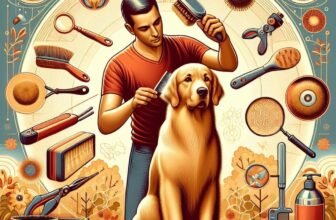
Check out our latest products
When it comes too pet care,grooming plays a crucial role in maintaining not just appearance but overall health. A well-groomed pet is a happy pet, and investing time in grooming can lead to a myriad of benefits, including healthier skin and a shinier coat. Whether you’re the proud owner of a fluffy feline or a dapper dog,understanding the essential grooming tips can make all the difference. In this article, we’ll explore key practices and recommendations for taking care of your pet’s skin and coat, ensuring they look and feel their best. From brushing techniques to bathing basics, we’ll dive into effective routines that promote a healthy, vibrant appearance for your beloved companion. Let’s get started on the journey to better grooming!
table of Contents
- Understanding the Importance of regular Grooming for Skin and Coat Health
- Choosing the Right Products for Your Skin and Coat Care Routine
- Techniques for Effective Brushing and Bathing
- Signs of Skin Issues to Watch for and when to Seek Professional Help
- Concluding Remarks
Understanding the Importance of Regular Grooming for Skin and Coat Health
Regular grooming is not just a matter of aesthetics; it plays a vital role in your pet’s overall well-being. A well-maintained coat can help prevent skin issues such as allergies, irritation, and infections. By routinely brushing your pet, you can remove dirt, debris, and loose hair, which minimizes the risk of matting and promotes a smooth, healthy coat.this practice also stimulates blood circulation, leading to a shinier and more vibrant appearance. Additionally,grooming provides an excellent opportunity to inspect your pet’s skin for any irregularities,helping to catch potential health problems early.
Moreover, grooming sessions serve as an essential bonding experience between you and your pet. These moments of care allow you to build trust while also reinforcing a sense of comfort and safety. Here are some key points to consider when it comes to maintaining your pet’s skin and coat health:
- Brush Regularly: Establish a consistent brushing routine based on your pet’s coat type.
- Choose the Right Tools: Use brushes and combs suited for your pet’s specific needs.
- Bathe appropriately: Use gentle shampoos designed for animals, and don’t over-bathe.
- Hydrate the Skin: consider using conditioners or moisturizers to keep the skin hydrated.
- Monitor Diet: Good nutrition directly impacts skin and coat health; ensure your pet has a balanced diet.
Choosing the Right Products for Your skin and Coat Care Routine
When it comes to maintaining your pet’s skin and coat, selecting the right products is crucial. Not all fur types or skin sensitivities are the same, and thus, tailoring your choices to your animal’s specific needs is essential. Begin by examining the individual characteristics of your pet—considering factors like breed, coat length, and any existing skin conditions. For instance, dogs with sensitive skin may benefit from hypoallergenic shampoos, while long-haired breeds often need moisturizing conditioners to combat tangles and dryness.
In addition to shampoos and conditioners, consider the use of topical treatments and supplements that can further enhance skin health. Here are a few components to keep in mind when selecting your products:
- Ingredients: Look for natural, nourishing components like coconut oil or oatmeal that soothe skin irritations.
- pH Balance: Choose products that maintain a proper pH balance suitable for your pet.
- Formulation type: Decide between gels, sprays, or creams based on your pet’s needs and preferences.
Its also beneficial to consult your veterinarian when in doubt,as they can provide tailored recommendations and help you avoid products that may aggravate your pet’s skin or coat type.
Techniques for Effective Brushing and bathing
Maintaining a healthy coat begins with mastering proper brushing techniques. Regular brushing not only keeps your pet’s fur looking pristine, but it also assists in distributing natural oils, promoting a lustrous shine. Choose a brush that suits your pet’s coat type—slicker brushes are excellent for removing mats in long-haired breeds, while bristle brushes work wonders on short-haired pets. During brushing sessions, take your time; work through tangles gently to avoid discomfort. Aim for at least two to three times a week to ensure that dead hair and dirt are consistently removed, keeping allergens at bay.
Bathing plays a critical role in your pet’s hygiene and overall skin health. Choose a high-quality pet shampoo tailored to your specific animal,being cautious to avoid human products that could irritate their skin. When washing, ensure that your pet is cozy and calm; using lukewarm water can make the experience pleasant.Create a gentle lather, massaging the scrub into their coat while paying attention to hard-to-reach areas such as underbelly, paws, and behind the ears. Rinse thoroughly to eliminate any residue, and consider using a conditioner for extra moisture, especially for long-haired breeds.
Signs of Skin Issues to Watch For and When to Seek Professional Help
Maintaining the health of your skin is crucial for overall well-being, and there are certain signs that can indicate potential issues. Look out for redness, itchiness, or irritation that persists over time. Other symptoms to be vigilant about include dry patches that are flaky or scaly, unusual bumps or growths, and changes in colour of existing moles or spots. If you notice any excessive peeling or a sudden change in texture, it’s essential to pay attention and assess your skincare routine to see if any products may be causing sensitivity.
In cases where these symptoms escalate or if your skin condition is accompanied by systemic symptoms like fever or joint pain, it’s crucial to consult a professional.Additionally, consider seeking help if you experience severe acne that doesn’t respond to over-the-counter treatments, or if you have persistent eczema or psoriasis flare-ups. remember that early intervention can often lead to better outcomes, so don’t hesitate to contact a dermatologist if you are unsure or concerned about your skin’s health.
Concluding Remarks
maintaining a healthy skin and coat for your pet is a multifaceted process that requires consistency, care, and a bit of know-how. By incorporating these essential grooming tips into your routine, you can definitely help ensure that your furry friend not only looks their best but also feels comfortable and happy in their own skin. Remember, grooming is more than just a luxury; it’s a basic aspect of overall health that can prevent various issues down the line. Regular check-ups, appropriate products, and attentive care will go a long way in keeping your pet’s skin and coat vibrant and healthy. Thank you for joining us in exploring these tips, and happy grooming! Your pet will appreciate it!










